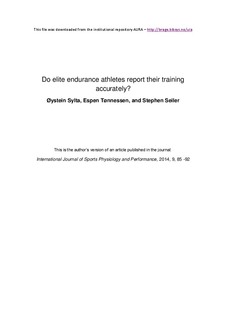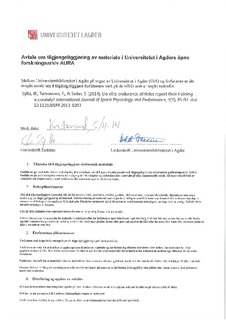| dc.contributor.author | Sylta, Øystein | |
| dc.contributor.author | Tønnessen, Espen | |
| dc.contributor.author | Seiler, Stephen | |
| dc.date.accessioned | 2014-11-05T07:53:32Z | |
| dc.date.available | 2014-11-05T07:53:32Z | |
| dc.date.issued | 2014 | |
| dc.identifier.citation | Sylta, Ø., Tønnessen, E., & Seiler, S. (2014). Do elite endurance athletes report their training accurately? International Journal of Sports Physiology and Performance, 9(1), 85-92. doi: 10.1123/IJSPP.2013-0203 | nb_NO |
| dc.identifier.issn | 1555-0265 | |
| dc.identifier.uri | http://hdl.handle.net/11250/225353 | |
| dc.description | Author's version of an article in the journa.: International Journal of Sports Physiology and Performance. Also available from the publisher at: http://dx.doi.org/10.1123/IJSPP.2013-0203 | nb_NO |
| dc.description.abstract | Purpose: The purpose of this study was to validate the accuracy of self-reported (SR) training duration and intensity distribution in elite endurance athletes. Methods: Twenty-four elite XC skiers (25 ± 4 yr, 67.9 ± 9.88 kg, 75.9 ± 6.50 mL . min-1 . kg-1) SR all training sessions during a ~14 d altitude training camp. Heart rate (HR) and some blood lactate (La-) measurements were collected during 466 training sessions. SR training was compared to recorded training duration from HR monitors, and SR intensity distribution was compared with expert analysis (EA) of all session data. Results: SR was nearly perfectly correlated with recorded training duration (r = .99), but SR was 1.7 % lower than recorded training duration (P < .001). SR training duration was also nearly perfectly correlated (r = .95) with recorded training duration > 55 % HRmax, but SR was 11.4 % higher than recorded training duration > 55 % HRmax (P < .001) due to SR inclusion of time < 55 % HRmax. No significant differences were observed in intensity distribution in zones 1-2 between SR and EA comparisons, but small discrepancies were found in zones 3-4 (P < .001). Conclusions: This study provides evidence that elite endurance athletes report their training data accurately, although some small differences were observed due to lack of a SR “gold standard”. Daily SR is a valid method of quantifying training duration and intensity distribution in elite endurance athletes. However, additional common reporting guidelines would further enhance accuracy. | nb_NO |
| dc.language.iso | eng | nb_NO |
| dc.publisher | Human Kinetics | nb_NO |
| dc.subject | XC skiers | nb_NO |
| dc.subject | heart rate | nb_NO |
| dc.subject | validity | nb_NO |
| dc.subject | self-report | nb_NO |
| dc.subject | expert analysis | nb_NO |
| dc.title | Do elite endurance athletes report their training accurately? | nb_NO |
| dc.type | Journal article | nb_NO |
| dc.type | Peer reviewed | nb_NO |
| dc.subject.nsi | VDP::Medical disciplines: 700::Sports medicine: 850::Exercise techniques: 851 | nb_NO |
| dc.source.pagenumber | 85-92 | nb_NO |
| dc.source.volume | 9 | nb_NO |
| dc.source.journal | International Journal of Sports Physiology and Performance | nb_NO |
| dc.identifier.doi | 10.1123/IJSPP.2013-0203 | |

